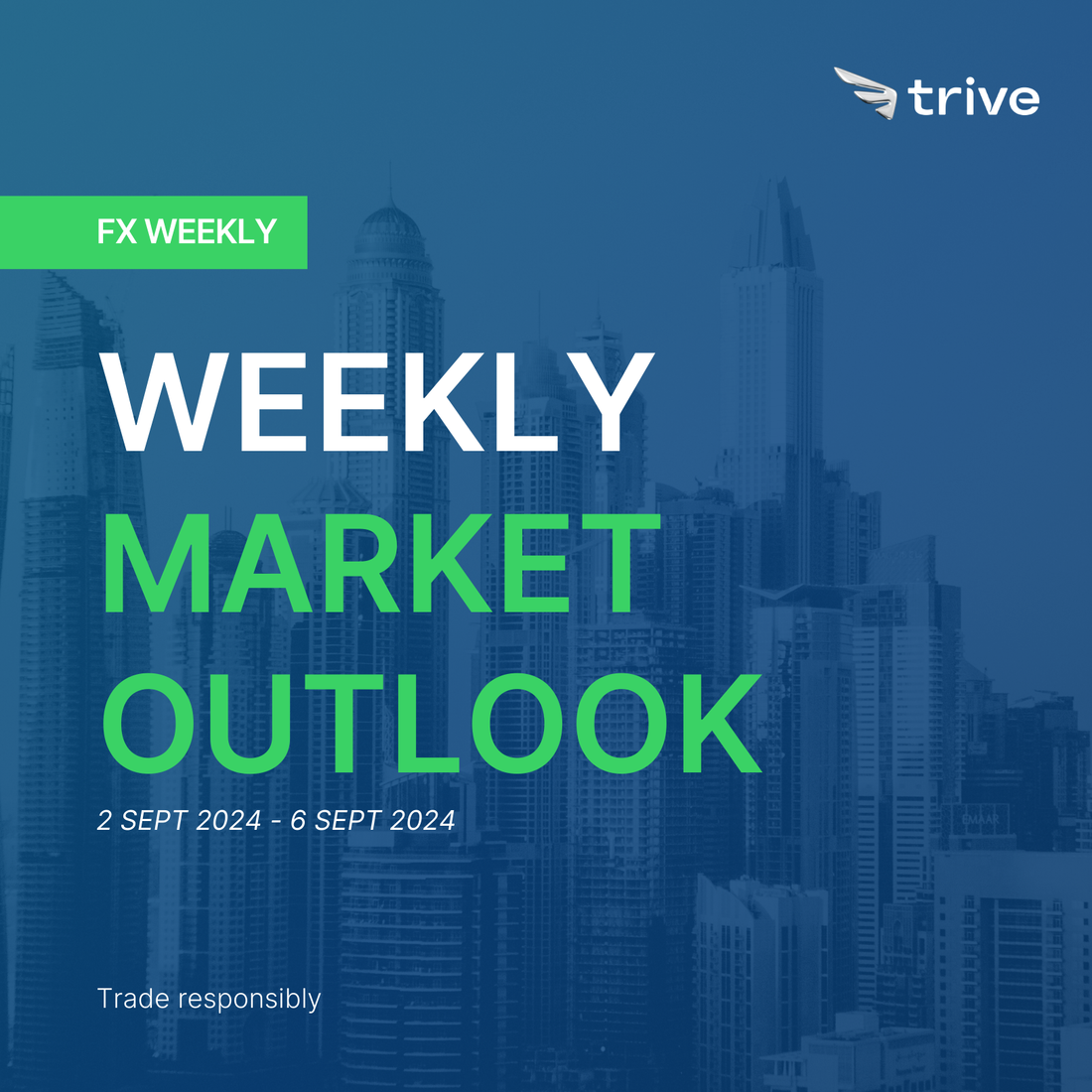FX Weekly: Trive’s Week Ahead Insights

This week highlights include the US Nonfarm Payrolls report as well as the Manufacturing and Services ISM PMI data. In Canada, the BoC rate decision will be eyed ahead of the next jobs report. Elsewhere, Australian GDP and Swiss CPI will be in focus. Note, US is away for Labor Day on Monday.
SWISS CPI (TUE)
This will be the second CPI print of Q3, following a 1.3% Y/Y rate in July. For the quarter as a whole, the SNB forecast inflation at 1.5% after it averaged 1.36% in Q2, incrementally cooler than their forecast for 1.4%. The release will factor into the SNB’s deliberations in September, but another 25bps cut is the base case with 32bps of easing implied. As a reminder, September is the final meeting with Chairman Jordan who will be replaced by current Vice Chairman Schlegel. Elsewhere, any further insight into the recent adjustment of sight deposit remunerations and remarks from export lobby group Swissmem on the currency will be sought; towards the start of August, Swissmem said the fair value for EUR/CHF was 0.98, at a time when it was at 0.92 and called for the SNB to curb currency strength as the lower inflation environment in Switzerland vs peers means the SNB can afford to allow the currency to weaken a touch. A point that Jordan acknowledged in recent remarks is that the exchange rate makes the situation difficult for the Swiss industry.
US ISM MANUFACTURING PMI (TUE)
Currently, the consensus looks for a rise to 47.8 in August from 46.8 in July. As a comparison, S&P Global's flash PMI data for August showed the manufacturing PMI falling from 49.6 to 48.0, signalling a deterioration in business conditions for a second straight month, and the steepest rate of deterioration since December. The report noted that all five components of the PMI weakened in August. "Increased rates of decline for new orders and inventories were accompanied by the first fall in factory production for seven months," S&P wrote, "employment growth meanwhile slowed to near-stagnation, and suppliers’ delivery times also shortened to the greatest extent since February, in a sign of suppliers being less busy amid weaker demand for raw materials." It also noted that inventories of finished goods were up sharply for the third time in the last four months, with the recent accumulation on unfinished inventory having been amongst the largest recorded in the history of the survey, often reflecting weaker than expected sales.
BOC POLICY ANNOUNCEMENT (WED)
The latest Reuters Poll revealed that the BoC is expected to cut rates to 4.25% on September 5th, the third consecutive 25bp rate cut. Slowing growth and a cooling labour market will likely keep inflation from rebounding, with the latest inflation report seeing the BoC eyed average return closer to target. Attention will likely lie on the statement and following press conference where participants will be looking for clues of further easing. The Reuters poll found that analysts expect Canadian interest rates to end 2024 at 3.75%, according to 20 of the 28 surveyed, while seven see the year-end rate at 4.00% and one economist sees it at 3.50%. In July, Governor Macklem noted that if inflation continues to ease broadly in line with their forecast, it is reasonable to expect further cuts in the policy interest rate, but the timing will depend how the BoC sees opposing forces of inflation play out, noting overall economic weakness is pulling inflation down, but price pressures in shelter and other services are holding inflation up. The prior statement also acknowledged that risks to the inflation outlook are balanced, dropping the language from April that the BoC was more concerned about upside risks. Money markets currently price in 25bp cuts at each meeting for the remainder of 2024, the July inflation data saw the average of the BoC core measures ease to 2.43% with the prior revised down to 2.57% from 2.60%, enforcing rate cut expectations. The July Jobs report saw a decline on the headline, but it was primarily led by part time jobs with full time jobs surging. The unemployment rate surprisingly was left unchanged at 6.4%, despite expectations for a tick up to 6.5%. Nonetheless, with slowing growth and inflation seemingly returning to target, the BoC has scope to continue with 25bp rate cuts.
AUSTRALIAN GDP (WED)
There are currently no expectations for the Australian Q2 GDP metrics, with the Q/Q at 0.1% in Q1 and the Y/Y at 1.1%. On GDP, the August RBA SoMP suggested “partial indicators suggest that GDP growth remained subdued in the June quarter”, whilst “ growth in Australia’s major trading partners appears to have eased a little more than expected in the June quarter, driven by weaker growth in China.” From a policy perspective, the RBA remains concerned about inflation as per the most recent RBA communication and the above-forecast Aussie CPI. As a reminder, the RBA stuck to its hawkish tone in the latest gathering in which it reiterated that the Board remains resolute in its determination to return inflation to the target and is not ruling anything in or out, as well as reiterated that inflation remains above target and is proving persistent.
US ISM SERVICES PMI (THU)
Currently, the consensus expects a trivial rise to 51.5 in August from 51.4 in July. As a gauge of comparison, S&P Global's flash PMI data for the month noted services business activity rising to a two-month high of 55.2 (albeit, from 55.0). The survey compiler said that while the data paints a solid growth picture, and points to robust GDP growth in Q3, allay fears of a near-term recession, along with a fall in selling price inflation to a level close to the pre-pandemic average, growth has become increasingly dependent on the service sector as manufacturing, which often leads the economic cycle, has fallen into decline. That said, the report noted that service sector growth was being constrained by hiring difficulties, which continue to push up pay rates, and means that overall input cost inflation remains elevated by historical standards.
US NONFARM PAYROLLS (FRI)
The US is expected to add 163k nonfarm payrolls to the economy in August (prev. 114k; vs 3mth average 170k, 6mth avg of 194k, and 12mth avg of 209k). The unemployment rate is expected to fall to 4.2% from 4.3% (note: FOMC forecasts made in June saw the jobless rate at 4.0% this year, rising to 4.2% in 2025). The rate of average hourly earnings growth is expected to pick up to +0.3% M/M in August (vs 0.2% in July; 3mth avg +0.3%; 6mth avg +0.27%); Capital Economics said the soft July data sparked fears that the Fed could kick off its rate cutting cycle with an upsized 50bps rate reduction, but there is reason to treat that data with caution given the spike in the number of people forced to work part-time or unable to work at all due to the weather, suggesting that Hurricane Beryl did in fact have a significant impact. CapEco reckons the weather conditions subtracted around 30k from the July headline, which should be reversed in August. More broadly, however, CapEco notes that despite some signs of stabilisation, hiring activity has generally weakened, with the ISM and S&P Global indices at pandemic lows and weak service sector data. "Arguably the bigger shock in the July was the 0.2ppts rise in the unemployment rate, which triggered the Sahm rule," but suggests that temporary disruptions, mainly in the auto sector, were to blame," adding that "if most of these temporarily laid-off workers returned to their jobs in August as we expect, the unemployment rate would drop back to 4.2% or possibly even 4.1%." Other analysts have suggested that the August jobs data will be influential in determining how the Fed kicks-off its rate cutting cycle. Currently, money markets are fully discounting a 25bps rate cut, but have assigned a probability around 30% of an upsized 50bps reduction.
CANADIAN LABOUR MARKET REPORT (FRI)
The Canadian labour market report will be digested to help determine the future path of easing from the BoC, with the Bank widely expected to cut rates in September, it will likely have more influence on meetings throughout the year. Rates are currently at 4.50%, and the majority of analysts expect rates to end 2024 at 3.75%, although seven analysts polled see rates at 4.00%, while one sees rates at 3.50% (there are only three meetings left for the year, including September). The majority of analysts are in line with current market pricing, which sees a 25bp rate cut in September, October and December. A weak report may add conviction to some of the more dovish calls.
Disclaimer
This material is provided for informational purposes only and does not constitute financial, investment, or other advice. The opinions expressed in this material are those of the author and do not necessarily reflect the views of Trive International. No opinion contained in this material constitutes a recommendation by Trive International or its author regarding any particular investment, transaction, or investment strategy. This material should not be relied upon in making any investment decision.
The information provided does not consider the individual investment objectives, financial situation, or needs of any specific investor. Investors should seek independent financial advice tailored to their individual circumstances before making any investment decisions. Trive International shall not be liable for any loss, damage, or injury arising directly or indirectly from the use of this information or from any action or decision taken as a result of using this material.
Trive International may or may not have a financial interest in the companies or securities mentioned. The value of investments may fluctuate, and investors may not get back the amount they originally invested. Past performance is not indicative of future results.
For more information about Trive International, please visit http://trive.com/int
Additional Information
Investing involves risk, including the potential loss of principal. Diversification and asset allocation strategies do not ensure a profit or guarantee against loss. The content in this material is subject to change without notice and may become outdated or inaccurate over time. Trive International does not undertake any obligation to update the information in this material.
By accessing this material, you acknowledge and agree to the terms of this disclaimer. If you do not agree with these terms, please refrain from using this information.
No comments
Home
Trive
TriveHub





0 comments